Text
Fantasy Rom-Coms
The genre I never knew I needed. Until I found it.

Short 'n' sweet book rec post today (because I know I've been doing a lot of deep-dive analyses of late). I deserve a break. You deserve a break. So let's do it.
Here's my top three fantasy rom-com series at the moment!
Pick them up if you enjoy a bit of smutty fantasy and are in the mood to laugh.
1. Anything by Kimberly Lemming

I do not know if my tits were built for murder. I don't even think they were built with my back in mind.
Lemming is an auto-buy author for me. This woman is bloody hilarious. The humour is farcical and somewhat absurdist, which is my absolute favourite style. I grew up with the likes of Monty Python, The Mighty Boosh, and The Confessions of Georgia Nicholson - so Lemming's work is right up my alley.
Her character Alexis, the dirty-talking sword (yes, you read that correctly) is, in my mind, nothing short of comedic genius.
"Oh my god, chip my steal, you're so annoying," Alexis snapped. "Maybe if you fixed your attitude and took a bath once in a while, women would talk to you. You smell like old cheese and a mother's regret."
I know some reviewers have been thrown off my the modern vernacular in Lemming's work, due to its medieval-like fantasy setting. However, I think that is exactly what makes these books so good (and refreshing).
The love interests speak a bit more "ye oldy", while the female protagonists speak like we do. The result is something akin to what might happen if a modern romance reader were dropped into a smutty fantasy world. It's brilliant. For example:
"Every scratch," he whispered, his tone gentle and comforting. "Every bruise, I will pay back in fire and blood."
I blinked. "Um... that is so sweet but so unnecessary."
I'd recommend reading Lemming's work in publication order, which is as follows (links included):
That Time I Got Drunk and Saved a Demon
Mistlefoe (novella - available with KU)
That Time I Got Drunk and Yeeted a Love Potion at a Werewolf
Two Scoops of Hellfire (novella - standalone - available with KU)
A Bump in Boohail (novella - available with KU)
That Time I Got Drunk and Saved a Human
2. Alphas of Nasila series by V.K. Ludwig
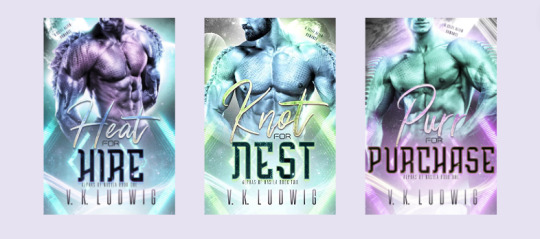
“If you ever see me running in heels, then you better run, too,” she says with a scoff. “What am I supposed to run away from, anyway?”
“Me!”
“Why? You got a chase kink or something?”
The best way I can think to describe this series is that it is Omegaverse satire. The pairings are alien males and human females, and the smut / romance includes all your fairly standard A/B/O tropes - with the exception of non-con. The consent is refreshingly solid here.
Book one of this series, Heat for Hire, was actually my entry into the Omegaverse. If you're unfamiliar with the genre, then this is a good place to start because the protagonist, Elli, is unfamiliar with how alpha/omega pairings work. So all the... ahem... knotting, heat cycles, etc. are explained via her first experience of them.
My skin prickles at the memory of Rhen’s growl. But only until I remember that I rubbed myself to orgasm on a civil servant.
However, book two, Knot for Nest is by far the best of the series, in my opinion. The chemistry between the two protagonists, Lucy and Tjor, is brilliant - and it's just a genuinely hilarious read. Lucy is a snarky, independent omega who absolutely knows how to play the big, bad alphas to her advantage.
Book three, Purr for Purchase, is a lot higher angst (and less comedic) than its predecessors. It wasn't really my cup of tea, but that's just because I'm not a huge fan of pregnancy in romance.
If you've tried the Omegaverse before but not enjoyed it because of the power imbalances or dub/non-con, then I'd still recommend this series. The Omega / Alpha dynamic is very much reserved for the bedroom and does not reflect how the couple interacts outside of it. This is particularly true of Lucy and Tjor. She might enjoy being "dominated" during sex, but she genuinely holds all the power in the relationship.
“Big, bad alpha, all calm and well-behaved between my thighs.”
The characters in each Alphas of Nasila book are interconnected and the events chronological. However, you do not necessarily have to read these books in order. If you're sceptical of the Omegaverse in general, start with book two. All these novels are available with KU.
3. Claws & Cubicles Series by Kate Prior

Some people really haven’t adjusted to life under the Dark Reign of Terror yet. Some things are different, but honestly it’s all cosmetic. Things aren’t that different from when we had a normal, living CEO.
This series is like The Office, but with monsters (and smut). The dry, relatable humour of a boring corporate job - but with non-human co-workers like orcs, the undead, etc - is genius.
The comedy definitely leans into that classic British deadpan / understatement style. Think IT Crowd, Faulty Towers, and After Life. I think anyone who's ever worked in an office will definitely be smirking and chuckling their way through this series.
“You could have just called me in. I’ve got skin.” I wonder if that last remark is rude or something. After all, he doesn’t really have skin, to my knowledge. I hope I don’t have to take an undead sensitivity training class now.
Book one, Live Laugh Lich, gets pretty kinky (the MMC has three... er... yes). The smut here isn't going to be for everyone. But I liked the humour so much that I didn't really mind if the intimate scenes weren't my cup of tea.
However book two, The Orc From the Office, holds a much broader appeal, I think. I adored this installment. I'd recommend pushing through and reading this, even if you had mixed feelings on book one. The orc MMC is a socially awkward cinnamon roll and I love him.
I wonder distantly if my health insurance covers being eviscerated by Orc cock.
Book three, The Gargoyle from General Management, left me a bit wanting in terms of the character development. However, the setting of everyone being away together on a company retreat was comedy gold.
All of the Claws & Cubicles books are available on KU.
That's all! I hope you enjoy the smutty rom-com fantasy recs!

This post includes affiliate links to help me create content. No pressure to use them! But if you do, I'll be very grateful :)
#book recs#fantasy romance#romance#smut#book recommendations#sci fi romance#romantasy#omegaverse#kimberly lemming#vk ludwig#kate prior#alphas of nasila#mead mishaps#claws and cubicles#monster romance
26 notes
·
View notes
Text
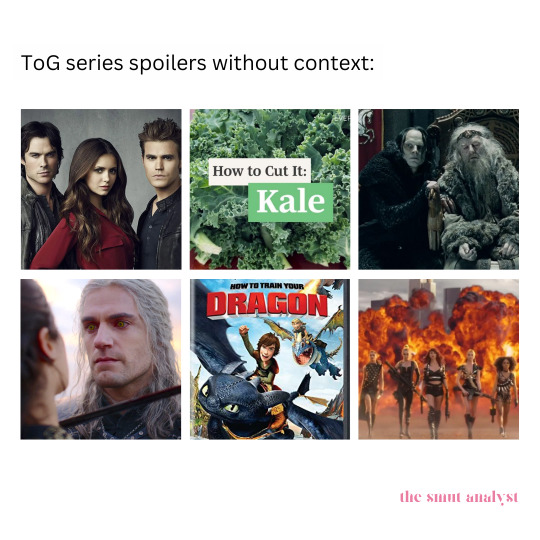
#the smut analyst#smut meme#smut memes#throne of glass#sjmaas#sjm books#sarah j maas#book memes#romance memes#fantasy memes#book club#book tumblr#aelin galathynius#chaol westfall#manon blackbeak#rowan whitethorn#dorian havilliard#spoilers without context
106 notes
·
View notes
Text
A defence of the Good Guy / Bad Boy love triangle
It is no secret that mainstream YA & NA fantasy gravitates towards an angsty love triangle. But is this trope's popularity due to vapid teenage vanity... or something far deeper?

Warning: in this post, I will be referencing: True Blood/The Southern Vampire Mysteries, Legendborn, A Court of Thorns and Roses, The Shadow and Bone Trilogy, Buffy the Vampire Slayer, The Hunger Games, Chilling Adventures of Sabrina, and The Vampire Diaries. Some minor spoilers, mostly relating to the romance side of things, may be involved.
I have stumbled across a bunch of articles lately analysing why love triangles are popular in YA and NA fiction - and all of them, in my opinion, missed the entire point.
Firstly, they focus entirely on the "love interests", while wilfully ignoring the fact that the romance element is often a subset of these stories, rather than the main focus (more on that later).
Secondly, these articles often attribute the appeal of the love triangle to "teenage vanity". They either directly state or imply that young women are drawn to the idea of "provoking" two men into a fight for their affection.

Look, I get it.
Or at least I get how a middle-aged man tap-tap-tapping away on his computer might draw that conclusion. Especially if the crux of his knowledge regarding female-centred fantasy rests on blog posts ripping apart Twilight.
But regardless, the fact remains that labelling YA love triangles as a conceited sexual fantasy is a gross over-simplification. Why? Because romance is rarely the point of the story. Instead, the love triangle is a vehicle through which the author complements and elevates the standard Hero's Journey plot beats.
To demonstrate this argument, I will go through each of the critical plot beats in the Hero's Journey. For each beat, I will demonstrate (with examples) how dual love interests can underscore the character development of the protagonist and highlight her emotional struggles during each stage.
The outline for this analysis will be as follows:
Introduction of the Female Protagonist / Refusal of the Call
Meet the Good Guy / Meeting the Mentor
Meet the Bad Boy / Tests, Allies, and Enemies
Death of Innocence / The Ordeal in the Abyss
Heartbreak / "Death" of the Mentor
Grief for Lost Innocence / Refusal of the Return
Self-Discovery / The Road Back Home
Female Protagonist Accepts Her New Self / Master of Two Worlds
For reference, here is a rough outline of the major plot beats in the Hero's Journey:
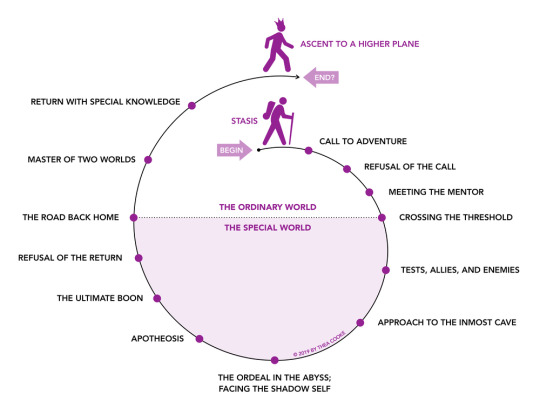
Alright. Time to rip apart some assumptions.
Let's go!
Introduction of the Female Protagonist
Refusal of the Call
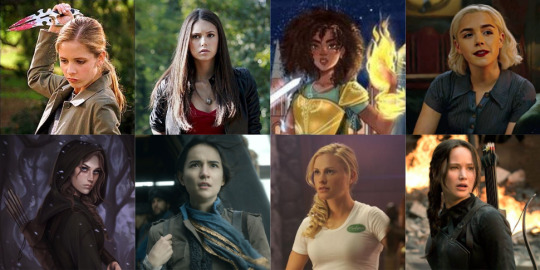
Mainstream fantasy love triangles almost always centre a female protagonist hence why people love to hate on them. The introduction of this protagonist generally follows your fairly standard Hero's Journey opening.
We meet the protagonist, usually a teenager or young woman, going about their "everyday life" in the ordinary world.
But then the Call to Adventure comes - sometimes referred to as the Inciting incident. For Feyre (ACOTAR), this moment is when she kills a wolf who turns out to be Fae. Or for Katniss (HG), her sister's name is drawn, prompting her to offer herself as a tribute instead.
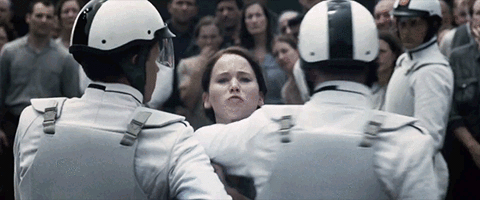
The Call to Adventure or Inciting Incident marks a point of no return - even though the protagonist might not realise it at the time. It is the moment when life as they know it ends. Afterwards, nothing will ever be the same, including the protagonist.
The following beat is usually the Refusal of the Call, where the protagonist resists any change coming their way. Buffy (BTVS), for example, wants to continue her life as a regular teenage girl instead of being burdened by the duties of being the Slayer. Similarly, Sabrina (TCAOS) is hesitant to participate in the dark baptism, scared of its implications for her ties to the mortal world.
But for the plot to move forward, something or someone needs to prompt the protagonist to leave the "ordinary" world behind - and in turn, take those first few tentative steps into the "special" world (unknown).
Enter...
Meeting the Good Guy
Meeting the Mentor

The Mentor doesn't always have to be an Obi-Wan-style character who teaches the protagonist everything they know about lightsabers. In its simplest form, the Mentor archetype is a guide. Someone who takes the protagonist by the hand, either literally or metaphorically, and leads them from the ordinary world into the special one.
This transition is known as Crossing the Threshold and it is the beat that marks the shift from Act I to Act II.
Now, there is a good reason why the Meeting the Mentor plot beat often serves as a precursor to Crossing the Threshold. And no, it isn't because the protagonist is incapable of doing anything by themselves.
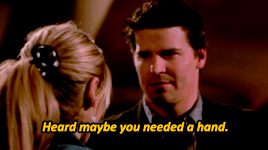
Instead, the Mentor character is often employed to explain how this new world works to both the protagonist and the reader alike.
Through the protagonist interacting with a "guide", the rules and systems of the new world can be revealed through dialogue and action, rather than excessive exposition and info-dumping.
And this is where the "good guy" as a Mentor character stand-in comes into play. His arrival serves the dual purpose of propelling the protagonist into the Crossing the Threshold beat and guiding her once she does.
For example, Sookie's budding romance with Bill is what introduces her (and us) to the Charlene Harris's world of vampires in True Blood. Or, in Tamlin's case, he takes his role in "helping" Feyre to cross the threshold quite literally and abducts her, forcing her to leave the human world behind in place of the world of Fae.

Now, there are quite a few exceptions to this good guy/mentor rule and they generally occur when the good guy is a childhood friend or sweetheart. Examples include Harvey (TCAOS), Gale (HG), and Malyen (SAB).
When this happens, the good guy often provides the protagonist with a much-needed link to her previous life and/or the ordinary world. He takes on more of a "grounding" role, rather than a guiding one.
But regardless, what these good guys have in common is a fairly standard set of traits. They are protective, have a strong moral compass, and are incredibly loyal to the protagonist.
Furthermore, they are almost always the protagonist's "first love". They offer her the emotional support she needs in order to move forward by making her feel less alone in the world.

Regardless of whether the good guy is a childhood friend or a mentor-like character, his relationship with the protagonist usually marks a time of both innocence and self-discovery. He is a source of love and companionship while the protagonist takes those first few tentative steps into the unknown.
Meeting the Bad Boy
Tests, Allies, and Enemies
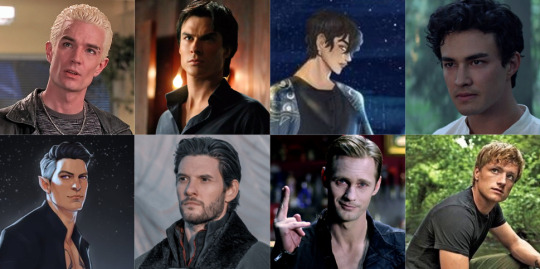
The Hero's Journey is, at its essence, a Bildungsroman-like story. Or at least it is in the YA/NA genres. It is a coming-of-age tale, with Crossing the Threshold being a symbol for leaving the child behind in order to discover the adult that awaits.
What follows is a collection of plot beats known as Tests, Allies, and Enemies. This stage of the story is often fraught with missteps and small triumphs, good times and bad times - much the same as adolescence.
And this is where the bad boy comes in.

Sometimes the bad boy manifests as an enemy who the protagonist must face in some kind of test like Spike to Buffy. Other times, he presents as a Temptation beat, like the Darkling does to Alina (SAB), trying to lure the protagonist away from their path.
But regardless of how he makes his entrance, the initial purpose of the bad boy is almost always to bring the protagonist face-to-face with the dangers of this new world.
For example, through Eric, Sookie realises that not all vampires are polite and restrained like Bill. Similarly, Feyre's first encounters with Rhysand show her an even darker side to the Fae.
Even bad boys who are not outright evil still tend to behave in a way that the protagonist finds confronting, like Peeta (HG), whose ruthlessly practical survival tactics disturb the very moral Katniss.
In this sense, the bad boy fashions himself into a symbol of the harsh realities of adulthood. Much as a child might find their first encounter with the cruelty of the world shocking, the protagonist is shocked and appalled by the bad boy.
We're not in Kansas anymore, Dorothy.

However, it is important to note that the bad boy is usually just one component of the beats involved in the Tests, Allies, and Enemies section. Again, this ties in with my argument that these stories are a Hero's Journey first - with the love triangle simply underscoring that fact.
The friendships that Buffy forms with Willow and Xander are shown to be her two most enduring relationships, while her love interests come and go. In Legendborn, Bree's quest to learn the truth about her mother's death has nothing to do with romance at all. And Sabrina's rivalry-to-friendship arc with Prudence gets significant screen time across multiple episodes and seasons.

During the Tests, Allies, and Enemies stage, the protagonist is usually starting to come into her own. She faces challenges, forms friendships, and encounters enemies. And yes, with love triangles there's usually some lust and romance thrown in there, too.
But the main focus of this stage is that the protagonist is starting to learn who she is. She is becoming more and more powerful with each setback and triumph.
The Death of Innocence
The Ordeal in the Abyss

The Ordeal into the Abyss, also known as The Belly of the Whale, is a plot beat where the protagonist encounters their greatest test thus far.
Rather than this beat being the climax of the story, The Ordeal is generally a challenge that the protagonist must face before the final confrontation or battle - and they must do so alone. It sees them hitting rock bottom and coming face-to-face with their greatest fear, whatever that may be.
This plot beat is a transformative one. It forever changes the protagonist and readies them for the final battle ahead. It is a death of innocence. The moment when the "girl" becomes the "woman", so to speak.

And in this sense, The Ordeal in the Abyss comes with loss and gain in equal measure. Yes, the protagonist is stronger for the experience, but not without cost.
To get to this point, she has been to hell and back. Sometimes literally (cough, cough. Sabrina). The protagonist is now well acquainted with the darkness of this new world but, in order to survive it, she has to absorb some of that darkness into herself.
If you gaze into the abyss, the abyss gazes into you.

The aftermath of The Ordeal usually sees the protagonist having conflicting feelings over what she has discovered about herself.
On the one hand, she might relish her newfound power and strength. But on the other hand, she may also be afraid of who she had to become in order to emerge triumphant.
Heartbreak
"Death" of the Mentor

The Death of the Mentor isn't always a literal death, but rather, it is a plot beat that forces the protagonist to stand on their own two feet.
By losing the mentor, the protagonist's safety net is ripped out from underneath them. It places them in a "sink or swim" situation that is critical to their growth as a character.
This is why the relationship with the good guy must either falter or end at some point, even if only temporarily. Their breakup serves as a stand-in for the Death of the Mentor plot beat.
Because despite romance featuring heavily in these stories, there is still an inherent idea within them that there are certain steps in a woman's coming-of-age that she must take alone.
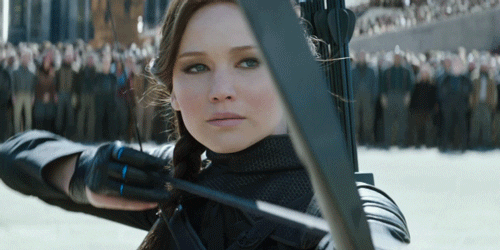
The cause of this breakup is almost always due to the transformation that the protagonist underwent during The Ordeal. The good guy no longer understands her, even though he may want to.
For example, Feyre's experience Under the Mountain sees her outgrow her coddled life with Tamlin. Similarly, when Katniss returns to 12, Gale can't fully comprehend what she went through, nor the role she is being forced to play as a result.
Grief for Lost Innocence
Refusal of the Return

The combination of The Ordeal and the Death of the Mentor take their emotional toll on the protagonist. She mourns for the girl she once was, the loss of her first love, and the ordinary world that is now a stranger to her.
What follows is a low point called The Refusal of the Return. Sometimes this beat sees the protagonist running away from her problems, as Buffy does when she flees Sunnydale after killing Angel.
Other times, The Refusal of the Return is a period of rebellion. Grief manifests itself into rage and the protagonist leans more heavily into that darker side of themselves that they discovered during The Ordeal. Like when Elena turns off her humanity following the loss of her brother.
It is usually during this stage that the bad boy begins to take on a more prominent role. (Welcome back to the plot, bad boys!)
At some point, either during this beat or perhaps earlier, we see a different side to the bad boy. Most often, this occurs when the bad boy shows the protagonist some kind of vulnerability, leading her to second guess her first impression.
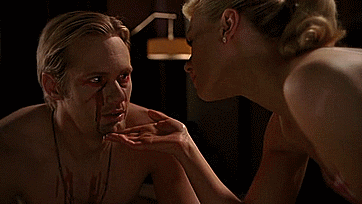
In the Darkling's case, Alina recognises his profound loneliness. Sookie witnesses Eric's grief at the loss of his maker, Godric. And Rhysand confides in Feyre about the horrors he endured at the hands of Amarantha.
However, seeing this "other" side isn't just a plot device to justify the protagonist's developing feelings for the bad boy. But rather, it serves as a mechanism through which the protagonist's assumptions and beliefs are thrown into question. Not just about the bad boy, but about the world in general.
Disrupting the protagonist's foundations is essential to nearly all emotionally-driven storytelling. Through shattering the her beliefs - whether it be in a system or person - the narrative is propelled forward as the protagonist is then forced into come to her own conclusions.
And this - THIS! - is where the "good guy / bad boy dynamic" becomes so much more than just a blatant over-simplification of male archetypes pandering to female sexual fantasy.
The dichotomy of "good" and "bad" expands here to represent larger choices that the protagonist has to make. Comfort or danger? Honour or Power? Altruism or ambition?

Furthermore, the protagonist's conflicting feelings about the two love interests underscores the very real push-and-pull we all feel during adolescence. Where we crave the adventure and independence of adulthood while simultaneously mourning the safety and protection of childhood.
And this is why the good guy / bad boy love triangle can be such a great plot device. It's not only fun to read (when done well) but it makes sense that the protagonist might find herself drawn to someone whose darkness matches her own.
Who the bad boy is - and what he has done - creates a safe space for the protagonist to explore this darker side of herself. To rebel. To fall apart. To be selfish for once, instead of selfless.

At a time when others in the protagonist's life, like the good guy or her friends, my judge or simply not understand her, the bad boy offers a reprieve. But whether this reprieve positively or negatively influences the protagonist tends to vary from story to story.
Sometimes he is the one who encourages her Refusal of the Return, as the Darkling does for Alina. Other times, the bad boy helps the protagonist in returning to her path, rather than luring her away from it, by offering her his understanding.
Peeta gets what Katniss is going through in a way Gale never can because he went through it, too. Similarly, Stefan can't provide Elena with the reassurance she needs after becoming a vampire because he has never come to terms with his own loss of humanity - therefore, enter Damon.
Self-Discovery
The Road Back Home
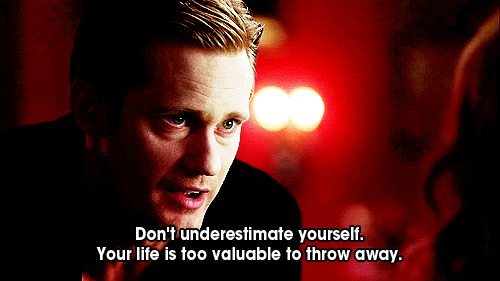
The Road Back Home sees the protagonist emerging from her Refusal of the Return. It is when she embarks on the journey to fully reconcile the girl she once was with the woman she has become. To do this, she needs to confront her trauma from The Ordeal and forgive herself for whatever darkness it might have awakened.
This is usually a gradual process that takes place over many chapters or episodes. In many ways, it is a mirror to the Crossing the Threshold beat. Except this time around, the protagonist is looking inwards not outward - instead of discovering the new world, she is discovering herself.
During this time, the bad boy's relationship with the protagonist is often explored more deeply. Being loved by the bad boy - darkness and all - is usually a precursor to the protagonist beginning to accept this darker side of herself, too.
But a distinction needs to be made here between "accept" and "embrace". The former does not necessitate the latter, and whether or not the bad boy gets his own redemption arc usually serves as the distinction between the two.

In the Darkling's case, he certainly helps Alina to come into her power, but ultimately, Alina rejects the path that he is trying to lead her down. The Darkling might have helped her to accept her darkness, but she does not fully embrace it the way he does.
Other times, when the bad boy gets his own redemption arc, we see a precursor to self-love through their relationship. Because in pursuing her feelings for the bad boy, the protagonist has to reconcile the fact that people are nuanced, and no one is entirely good nor evil. In forgiving the bad boy for his past wrongdoings, the protagonist sees that it is possible to forgive herself, too. Damon and Elena's arc (in the TV adaptation) is a good example of this.
But regardless of where things may or may not go with the bad boy, the next plot beat has nothing to do with romance at all. Now, the protagonist is ready for the final battle.
The Female Protagonist Accepts Herself
Master of Two Worlds

Everything the protagonist has been through has been leading her to this moment. Her triumphs, her defeats. Her discoveries and lessons. Her friends and mentors and lovers.
She's faced evil, maybe even embraced a little of it, and come out stronger and better for the experience. She has finished mourning the child she once was and accepted the woman she has become.
Now she is ready, as a master of both worlds, to face whatever comes next. And we, as readers, now get to enjoy the final battle!
Basically, the protagonist is a certified badass now - and she's going to win.
Now, where the romance goes during or after this plot beat is very, very varied. Sometimes, the protagonist stays with the bad boy, like Feyre does with Rhysand. Other times, the relationship is temporary, like Eric and Sookie. Or, in the case of Buffy, neither the good guy nor the bad boy remains in the picture. In fact, a very deliberate choice was made with her story to avoid an "end-game" romantic pairing.
And the reason why the romance is pretty damn varied is because, well, it doesn't really matter. The romance is the cherry on top of the story, not the whole damn cake.
Conclusion

I understand that love triangles might not be everyone's cup of tea - and that's okay. But to paint the entire trope under the broad strokes of teenage vanity and wish fulfilment is to do it a disservice.
Because for the most part, it isn't just some vapid romance. A lot of the most popular stories within the genre are actually complex YA fantasies in and of their own right, driven by your standard emotionally-driven, coming of age beats. They just happen to feature a female protagonist who falls in love.
Okay, maybe in this example she falls in love a few times. But so what? Getting your heart broken and mended again is a part of growing up, so why shouldn't it have a place in YA/NA fiction?
If young men are allowed to froth over some guy getting bitten by radioactive a spider and getting superpowers, then we can have two sexy vampires pining over the same girl.

#true blood#sookie stackhouse#southern vampire mysteries#love triangle#literature tropes#tv tropes#fantasy#fantasy romance#fantasy books#the vampire diaries#elena gilbert#buffy summers#buffy the vampire slayer#the hunger games#katniss everdeen#acotar#feyre x rhysand#feyre x tamlin#feyre#legendborn#bree matthews#shadow and bone#alina starkov#hero's journey#heroine's journey#the smut analyst#writing tips#romance plot#character building
79 notes
·
View notes
Text
Making Characters That Make Sense
Walk-through character template & "how to" guide for writing complex, original protagonists.
If you google "character templates for writing", you'll get a lot of very basic examples that read like a grocery list: eye colour, hair colour, skin colour, positive traits, negative traits, etc.
And sure, filling out this kind of template isn't completely useless - but it's also not particularly useful, either. Choosing whether your protagonist has blue eyes or green eyes isn't going to determine whether readers connect with them or not.
Instead, I prefer to use the below template:

There's some fairly left-of-centre categories here, so in this blog post I'll be creating a character from scratch to demonstrate what each section means and how to use the template effectively.
Primary Goal & Raison D'Être
Fantasy Romance is having a bit of a tournament-to-the-death moment right now, with Hunger Games-inspired stories like Fourth Wing, Throne of Glass, The Savior's Champion, and The Serpent and the Wings of Night in high demand - so that's what we're going to work with in today's blog post.
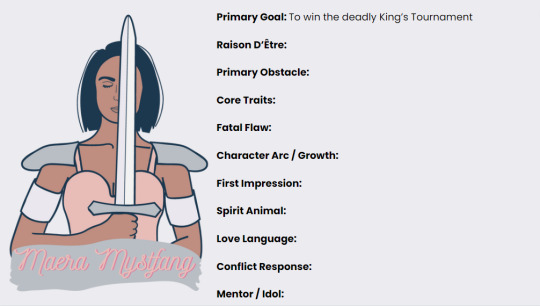
The story premise and primary goal of the protagonist are almost always interconnected. In this case, the story premise is a tournament to the death - and the character's main goal is to win that tournament, obviously.
But where there's room for some originality is in the raison d'être. This loosely translates to "reason for being" or "purpose". It's the why of it.
For example: what motivated this character to risk their life by entering such a tournament in the first place?
It is sometimes helpful to look at similar stories when thinking about this category. Not so you can copy their protagonist's motivations - but so you can do something different.
The whole selfless-self-sacrifice thing, for example - that's done. At least in relation to this particular sub-genre. We can do better for our hypothetical Maera Mystfang character.
Actually, let's really turn the trope on its head and make her raison d'être incredibly self-centred.

Already, this is character is shaping up to be something a little bit different within the niche of tournaments to the death. Which goes to show how putting a little bit of thought can go a long way, even with something as simple as identifying your character's initial purpose.
Primary Obstacle
Every protagonist needs a goal - and every goal needs an obstacle. This is what gives the story some tension and keeps readers turning the page.
An obvious choice of obstacle for this hypothetical character, since we're dealing with a fantasy romance, would be that Maera starts to develop feelings for one of her fellow competitors.
This concept has definitely been done, but that's okay. Not every section of this list has to break the mould. Tropes exist for a reason and it is totally okay to lean into them sometimes.
However, just for funsies, I'm going to try and put a slightly different spin on this one too.

Instead of the obvious "I love one of the people I'm meant to kill", let's make Maera's (previously dormant) conscience be the problem. Her reasons for entering the tournament may have been self-motivated, but as she gets to know her fellow competitors - admires some of them, even - she starts to second guess those reasons.
Core Traits
A lot of character templates will divide personality traits into positives and negatives - but I don't think this is particularly helpful. It is far too one dimensional - not to mention unrealistic. The key components of someone's personality aren't usually so black and white.
In fact, most core traits are both good and bad at the same time - it just depends on the context.
Instead of being wholly positive or negative, try to think of three core character traits that can serve as two sides of the same coin, with both positive and negative implications to each.

For Maera, I've given her these core traits:
Self-reliant;
Rebellious; and
Good-humoured.
Her self-reliance means that she is incredibly capable - but it's also the cause of her selfishness. She's always had to look after herself, so she expects others to do the same.
Her rebellious attitude means she isn't willing to accept the status quo. But at times she is also a rebel without a cause, causing trouble just for the fun of it.
Her good sense of humour means she is fun to be around, but she also tends to not take things as seriously as she should.
Thinking of core traits in this multi-faceted way not only adds realistic complexity, but it also sets you up well for showcasing character development and growth throughout the story.
Fatal Flaw & Character Arc / Growth
You've probably read negative reviews that throw around terms like "Mary Sue" or "Gary Stu". People tend to be over-zealous with these terms, especially for Mary Sue, but the gist of it is that the character in question is "too perfect".
They're the chosen one, they're good at everything, all the boys like them, etc.
Some characters can get away with this just fine. Look at Aragorn. He's the ultimate Gary Stu but I still swoon every time he opens those damn doors. You know the scene I'm talking about.
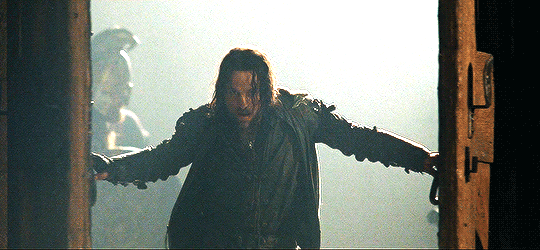
Ooft.
But for the most part, you want to incorporate a fatal flaw into your protagonists - because this is what gives them room to grow.
And, no. "I was born to be King but I don't wanna" does not count as a fatal flaw.
Instead, think bigger. Think worse. Think about where your character starts versus where you want them to end up. Think about how you want the events of the narrative to change their world view - or even their initial goal.

For Maera, her fatal flaw is pretty obvious, given her initial motivations for entering the tournament. Similarly, her growth/arc is linked to her primary obstacle, which is developing a conscious.
Her journey throughout this hypothetical story might be learning to appreciate how her past shaped her, while also acknowledging that there are things she can do to ensure others don't have to go through what she did. By being shown acts of kindness, she learns to appreciate their value.
First Impression
Now that we've covered all the "big picture" stuff, let's get into some of the smaller details that give your character some texture.
The first impression category is a hypothetical exercise where you image how your character might appear to a room full of strangers. In dual, multi, or omniscient POVs, you might even get the opportunity to include this impression somewhere in the story.
But even for first-person narratives, it is still worth thinking about, because it will help to inform how other characters interact and respond to your protagonist (at least at first).

For Maera, I've written this first impression as: a fun person to have a few drinks with - so long as you keep a close eye on your wallet.
From this description, we can guess that Maera probably likes to have a good time, but also comes across as untrustworthy. Whether that impression is deserved or not is up to you, as the author, to decide.
There's also a lot of deeper directions you can take this first impression category, too. Like if most people react to Maera this way, but one particular character doesn't, then your readers are going to sit up and pay extra attention during that interaction. Especially when that person reacting atypically is the future love interest.
Spirit Animal
Ah, this one is a fun one!
I always encourage my authors to assign a "spirit animal" to their characters - especially when they're doing multi-POV.
There are two main reasons for this:
It will allow you to assign some very distinct adjectives and verbs with that particular character; and
It is an opportunity to flesh out some additional character traits beyond the core traits.
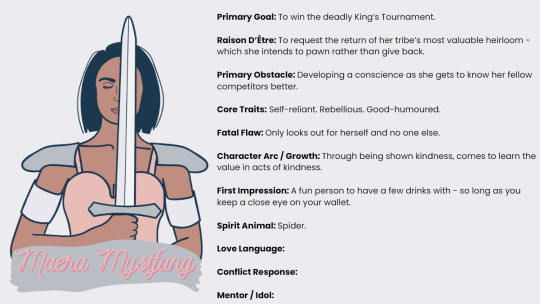
For Maera, I've chosen "spider" because she is solitary by nature, opportunistic, and patient.
But, more than that, I also like the idea of Maera being the kind of person who knows how to watch and wait. While her first impression might be "here for the good times", her joking façade is actually a mask she wears while carefully observing others.
For example:
Her words were laced with venom.
She crawled her way across the rooftop.
At some point, weaving lies had become more of a past time that a necessity.
Her thoughts were a tangled mess.
She didn't bother to conceal her predatory gaze.
Inch by cautious inch, she crept forward.
Her sanity was already hanging by a thread.
If there was one thing she knew how to do, it was spin a good story - truth be damned.
I've never outright compared Maera to a spider in these examples, nor have I made it blatantly obvious that that's what I'm doing. But by peppering these kinds or words throughout the story, I'll be able to subtly create a very distinct kind of impression for her character.
For comparison's sake, let's assign "cat" to the love interest. Examples of possible words to consider in this instance might be:
He clawed his way through the bushes.
"What are you doing?" he hissed.
The comment had some bite to it, that was for sure.
He slunk away into the darkness.
His still, unwavering focus was unnerving.
He prowled towards her.
In a few quick, agile steps, he'd made it across the parapet.
He yawned and stretched out beside her.
Of course, not every single word you use in association with a character needs to be related to their spirit animal. But keeping a certain type of animal in mind - and finding opportunities to throw in some subtle messaging through language choice - can be beneficial on so many levels.
It helps to distinguish your characters from one another through the kind of language you use to describe them - but it's also just really, really fun way to add some bonus texture to your characters. Giving your readers some little easter eggs like this is never a bad thing.
Love Language
If you're unfamiliar with the concept of the five basic love languages, then here's a quick visual overview:
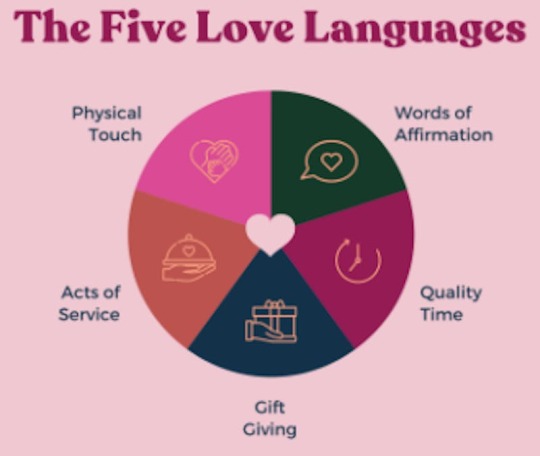
Love languages aren't a consideration that's specific to romance. They're important for friendships and familial relationships too.
Because thinking about what your protagonist values most in love is going to tell you a lot about who they are. Especially when you take the question deeper and think about why this is something they value.

For Maera, I've chosen "Acts of Service" because this ties in quite well to her character arc.
In terms of Maera's why, I could easily go with "because this was how she was shown love as a child" - and this is a good enough option most of the time. However, since her love language is very much tied into growing out of her fatal flaw, then I actually want to do the opposite.
Maera winds up valuing acts of service because this is something she craved - and wasn't given - as a child. She had to do things the hard way instead. Hence why she ends up appreciating the kindness of others so much. Such generosity is new to her - and precious.
Conflict Response
This is potentially one of the most overlooked character components. Conflict and tension is central to story telling, yet there is so little attention given to creating authentic, original responses to conflict.
The way I see it, there are three main considerations in regards to conflict response:
How your character reacts in the moment;
The unhealthy methods they use to deal with the aftermath; and
The healthy methods they use (or discover) to self-sooth.
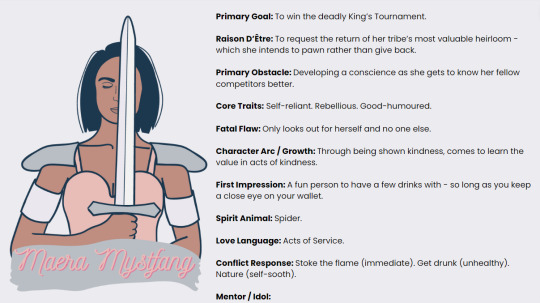
When faced with conflict, Maera's immediate reaction is to antagonise. She doesn't like to back down and enjoys creating trouble.
However, in the aftermath, the conflict affects her more than she lets on. She stews on it - and her solution to that is to get drunk until she can forget about it completely.
But even though she sometimes forgets it, Maera has a more healthy coping mechanism at her disposal. When she is surrounded by nature - in the forest, by the sea, whatever - it calms her.
In addition to identifying your protagonist's various responses to conflict, it is also helpful to think about why. Again, this is a great opportunity to insert something unique into their character backstory.
With Maera, for example, let's think about why she finds nature so soothing. Perhaps, amidst a very bleak childhood, one of her fondest memories is of picking grapes in a vineyard.
Perhaps the elderly woman who owned the vineyard was very rude and abrupt - but also quite kind to Maera in her own way. Maybe she would sometimes stitch up Maera's clothes or feed Maera a hearty, meaty dinner - even though she didn't have to.
If you're struggling to think of a real, tangible, unique memory such as this - then it's always helpful to go back to the old classic of write what you know. Think of a real life moment or memory - something that's stuck with you, no matter how simple - then adapt it to your character.
To create this vineyard example, I simply drew on my experience of picking strawberries with my Nonna after school.
Mentor / Idol
I could write an entire thesis on mentors. Or, more specifically, the "death of the mentor" trope - both in its literal and metaphorical interpretations.
But, for the sake of brevity, let's save that sh*t for another time and focus on what's important for a basic (yet complex) character template. And that is:
The Formative Mentor (past); and
Transformative Mentor (present).
The formative mentor (or idol) is someone who influenced your character prior to the events of the novel. Sometimes they're a character the reader will meet, or other times, they're long gone before the novel even begins.
The transformative mentor is a much looser term. It doesn't necessarily have to be a traditional mentor character, but rather it is a character who heavily influences or changes your protagonist throughout the events of the novel.

For Maera, I want her earliest idol to be a random female sell-sword who she crossed paths with. Prior to meeting this sell-sword, Maera was living without hope for a future, surviving on scraps and petty crime.
But after seeing an independent and moderately wealthy sell-sword in her local tavern, Maera got a glimpse into the kind of life that might be possible if she learned to fight. With the right kind of skills, she might be able to earn some decent money for a change - and travel the world.
This is an example of how "mentors" don't always have to be a wise wizard who oversees your protagonist's training and education. Young minds are impressionable - and even distant figures can have a lasting impact.
Just look at all the women who cite Legally Blonde as the reason why they were drawn to law. Elle Woods wasn't even real - but for plenty of young girls, she made an impact.
Similarly, your protagonist's "present" mentor or idol doesn't necessarily have to be a wise wizard either. It can simply be someone who motivates them to change their world view or strive to be better.
In romance, it is more than acceptable to have the present mentor coincide with the love interest - especially in standalone enemies-to-lovers. I know this seems counter-intuitive, since the word "mentor" implies a power imbalance, but it makes more sense if you readjust your definition of mentor to be "inspires change".
However, for Maera, I kind of like the idea of pairing her up with a love interest who shares some of her flaws. I vibe with the idea of making him a bit self-interested too, although for different reasons.
So in her example, I've listed the present mentor as a selfless secondary character. The way I would envision this going is Maera and the love interest team up early on - but somewhere along the way a secondary character saves them both. They're both heavily influenced by this character before this character sacrifices themselves. The aftermath of this incident rattles both Maera and her love interest, and serves as the spark for growth.
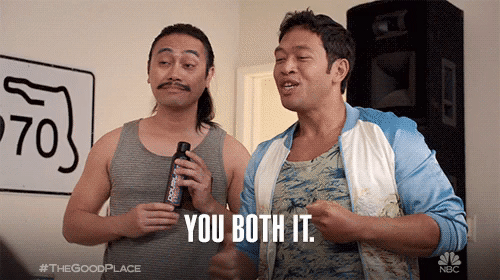
I hope you found this template - and very long explanation - useful!
#writing tips#character tips#book blog#writing#creative writing#character concept#originalcharacter#writeblr#writers on tumblr#writerscommunity#writer community#writer problems#writer things#original character#fantasy character#romance writing#writing advice#writer tips#writer tools#the smut analyst#raison d'etre#character traits#character tropes
164 notes
·
View notes
Text
Kinktober 2023: Monster Lovers Edition
A kinky Halloween reading list for all my monster lovin' girlies out there (part 1 of 2)
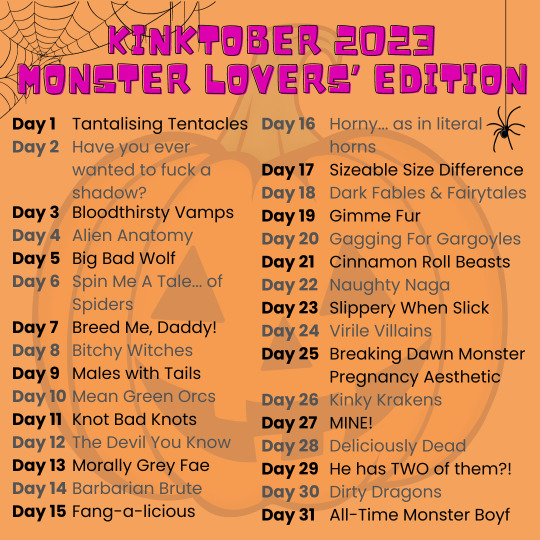



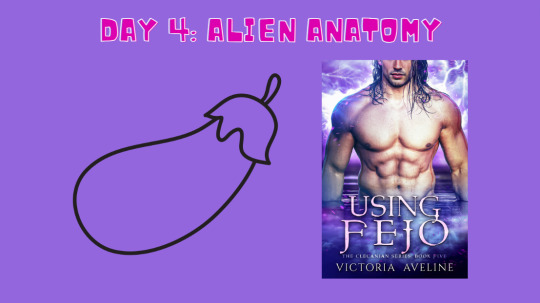


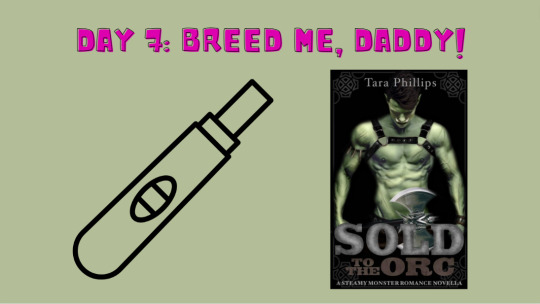


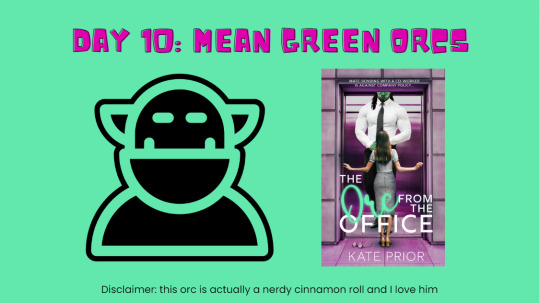




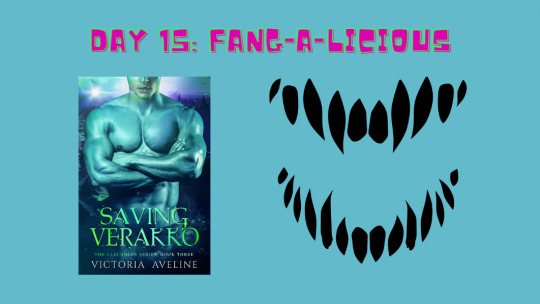
Hope you enjoyed Part 1 of the Kinktober 2023: Monster Lovers Edition list!
For links to the books mentioned above, simply click on the image!
Disclaimer: images include affiliate links which help me to keep creating content :) I appreciate your support xo
#kinktober 2023 monster edition#kinktober 2023#monster lovers#monster romance#monster smut#halloween reading#book recs#the smut analyst#smutty books#smut#romance#romance recs#smutty recs#smut recs#vk ludwig#kimberly lemming#victoria aveline#kathryn ann kingsley#kate prior#tara phillips#jillian graves#elizabeth stephens#colette rhodes#charlaine harris
54 notes
·
View notes
Text
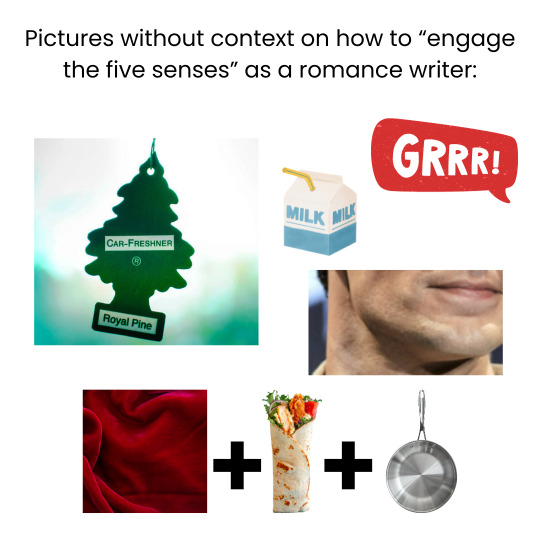
IYKYK.
Sarah, I am looking at you.
#smut#smut meme#romance#romance memes#sarah j maas#the smut analyst#smuttok#acotar#throne of glass#rhysand#dank memes
6 notes
·
View notes
Text
Woah. Disney got dark, bro.
5 deliciously dark and smutty Disney retellings that will send you straight to hell.
You're welcome.
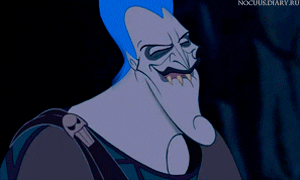
This blog post includes Amazon Affiliate links.
Always check trigger warnings before reading. Your mental health is important <3
1. A Ship of Bones & Teeth by Karina Halle
Ever wondered how different the Little Mermaid might have gone if Ariel was a man-eating siren?
Well, then have I got the rec for you...

I'm not exaggerating about the man-eating thing, by the way. In Karina Halle's version of Siren lore, they quite literally eat the hearts of men.
And yes.
This does occur on page.

Instead of being a re-telling of the Little Mermaid and Prince Eric falling in love, A Ship of Bones & Teeth instead transports us 10 years into their marriage - where things ain't looking so dandy for the reformed siren and her royal beau.
Turns out that (surprise, surprise) our protagonist, Maren (aka Ariel 2.0: Heart-Eating Edition), kind of regrets leaving the sea behind. Especially since Prince Eric turned out to be an abusive deadbeat who only liked her when she didn't have a voice.
But then Captain Ramsay "Bones" Battista enters the chat.
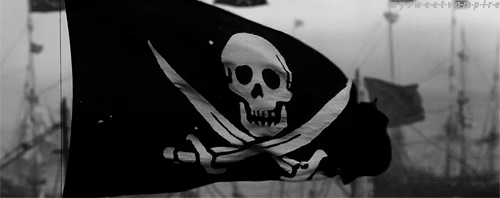
Alongside his notorious crew, Captain Bones commandeers the royal ship, and takes Maren as a prisoner. (And that's when things start getting better down where it's wetter, if ya know what I mean).
If you like your characters morally grey, your male leads with a bit of swagger, and your smut with a light dose of bondage - then add this book to your TBR.
Available for purchase here.
2. Luxuria by Colette Rhodes
Ever wondered how much more fun Beauty and the Beast might have been if Beauty had a serious monster kink?
Well then, look no further...

Far from the standard whiny, blushing bride that often accompanies the arranged marriage trope, Ophelia likes what she likes - and owns it.
And what she likes above all else is Shades - aka the "shadow demons" she was raised to kill by her family of Hunters. Yup. This version of Beauty has a serious monster kink.
So when a peace treaty is eventually brokered between the Hunters and the Shades - and part of that peace treaty involves sending a bride to the Shadow Realm to marry the king - Ophelia is like...
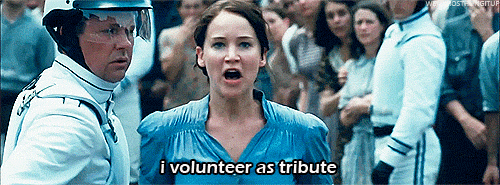
But instead of all her monster-banging fantasies coming true, Ophelia husband isn't interested. He's grumpy, suspicious, and does his best to intimidate his new wife every chance he gets.
Little does the King of Shades realise, however, that Ophelia is totally into all the snarling and growling. Instead of being scared, she's actually like...

It's a bit of a slow-burn to start, but once King Allerick realises that the scent his new wife keeps giving off is actually her arousal, not her fear? Well... Let's just say the slow-burn turns into a full-on forest fire.
If you like books that make you laugh out loud, your smut on the kinky and consensual side of the Omegaverse, and your male leads to be more monster than man - then this is the perfect book for you.
Available for purchase here.
3. Velvet Cruelty by Eve Dangerfield
Ever watched Snow White and thought about how much better it would have been if, instead of seven dwarves, we got multiple hunter characters instead?
Well then, fret not, cause Ms. Dangerfield's got you covered with...

This Snow White retelling does not hold back. It is brutal, seductive, and decadent.
This one's not for the faint of heart. The themes and the sexual content is dark as hell. Like, it puts the dark in dark. Fans of the Saints & Sinners Duet, or fans of Mafia Romance in general, probably won't blink an eye - but for anyone new to this sinful little corner of the romance section - proceed with caution.
Seriously. This is a code red: dead dove do not eat situation.

Unlike a lot of "why choose" romance, there's no skimming in terms of character development and complexity here. The four "hunters" are awful but - in typical Eve Dangerfield style - they're also damn interesting. This author is genuinely brilliant at weaving complex, unique characters that draw you in.
If you like your romance dark as hell, with villainous love interests and a generous smut-to-plot ratio, then give Velvet Cruelty a try.
Available for purchase here.
4. Escaping Wonderland by Tiffany Roberts
Ever wondered how you might feel if the Mad Hatter and Cheshire Cat characters were blended to make a crazy-yet-kinda-hot hybrid?
Alright, maybe not.
But regardless, I am here to present exactly that...

Let's face it. Alice in Wonderland is probably the one Disney movie that really didn't need to get more messed up. It's already a thinly-veiled acid trip as is. However, if you can count on anyone to throw in a bit more dark and twisted (ya know, just for fun) then its the writing duo that make up Tiffany Roberts.
The smut in this book actually isn't too out there (aside from the fact that the love interest is basically a humanoid cat). What makes this retelling especially dark though is its themes.
In Escaping Wonderland, Wonderland itself is actually a medically induced hallucination. One that psychiatric patients are subjected to against their will, until they eventually lose their grip on reality.

If these themes aren't a trigger for you, then I'd highly recommend giving Escaping Wonderland a try. It's the perfect romance for readers who enjoy when sci-fi and fantasy intersect, as well as for readers who don't mind a bit of monster in their male protagonists.
Available for purchase here.
5. Titan by Jillian Graves
Did you ever watch the Hunchback of Notre Dame and think that those gargoyles were a bit of alright?
Well then, hold my beer...
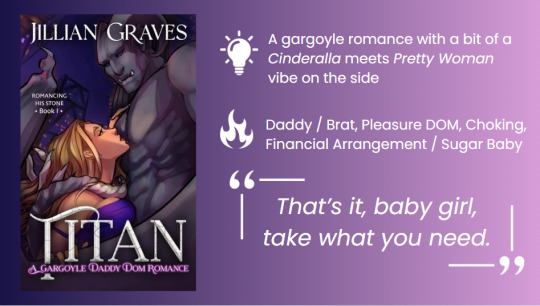
Yes, you read that correctly. This is a Daddy-DOM romance featuring a wealthy gargoyle. Don't judge me. Only the Lord can do that and I've already burned that bridge.
I gotta admit, before this book I avoided the daddy kink like the plague. But now I consider myself a convert. Now I am more like...

Titan also gets bonus pun for the series title. I mean... Romancing His Stone?!?!
Brilliant. 10 pun points for Gryffindor.
If you like books that are kinky and consensual, include some well-thought-out world-building, and that are sex worker positive to boot, then walk, don't run - Jillian Graves has got you covered.
Available for purchase here.
Hope you enjoyed this smutty Disney list.
I'll meet you all in hell!
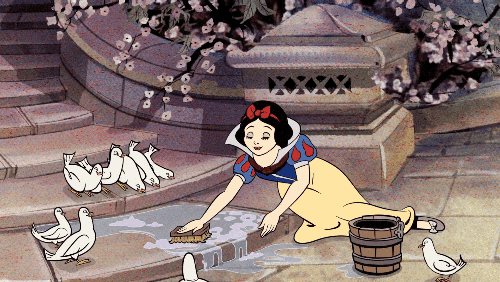
#romance#romance books#smut#indie author#indie books#monster romance#disney retelling#book review#book recommendations#book recs#kinktober 2023#fantasy romance#romantasy#book rec list#smutty books#dark romance#the smut analyst#tbr list
28 notes
·
View notes